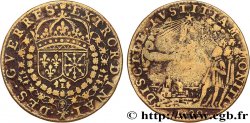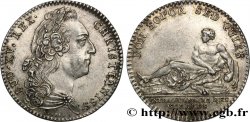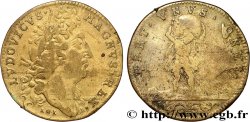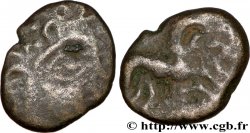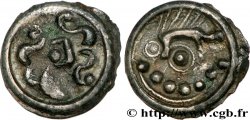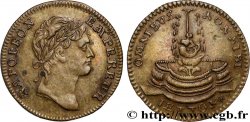fjt_827089 - EXTRAORDINAIRE DES GUERRES La prise des Baléares 1757
150.00 €
Menge
In den Warenkorb

Type : La prise des Baléares
Datum: 1757
Metall : Silber
Durchmesser : 28 mm
Stempelstellung : 6 h.
Gewicht : 7,02 g.
Rand cannelée
Seltenheitsgrad : R2
Kommentare zum Erhaltungszustand:
exemplaire nettoyé
N° im Nachschlagewerk :
Vorderseite
Titulatur der Vorderseite LUD. XV. REX. CHRISTIANISS.
Beschreibung Vorderseite Buste à droite de Louis XV non signé [n°332], type Guéant Prieur 626A. .
Übersetzung der Vorderseite Louis XV, roi très chrétien.
Rückseite
Titulatur der Rückseite HERCULE. BALLEARICUS ; À L'EXERGUE : EXTRAORDINAIRE. DES. GUERRES.1757.
Beschreibung Rückseite Hercule terrassant le monstrueux Géryon à trois têtes.
Übersetzung der Rückseite Hercule Balléarique.
Kommentare
Ce buste est vraiment rare et c’est en juin 2010 la première fois que nous le proposons à la vente. C’est l’exemplaire qui illustre le Guéant Prieur.
Il faut bien entendu prendre le titre Hercule Balléarique, du nom des Iles Baléares, de la même manière que le titre de Parthique ou de Sarmatique de certains empereurs romains : c’est l’endroit où furent accomplis des exploits, pas l’endroit d’origine du personnage.
Le buste cuirassé de Louis XV au droit d’ailleurs directement inspiré de l’iconographie militaire impériale romaine.
Nous trouvons l’explication de cette référence aux Baléares dans le récit de la guerre de Sept ans :
“La guerre maritime et coloniale fut celle dont les conséquences à long terme furent les plus sensibles pour la France, et dont les désastres ne purent jamais être réparés. Elle avait pourtant commencé par quelques succès français (prise des Baléares aux Anglais par le maréchal de Richelieu, en 1756), mais, l'inflexible William Pitt («le Premier Pitt»), devenu Premier ministre en 1757, allait mettre toute son énergie à exalter le réveil du sens national britannique et à mener dès lors sans défaillance, sur mer et aux colonies, la guerre contre la France.
La lutte fut particulièrement rude en Amérique. En 1758, après quelques succès du marquis de Montcalm, soutenu par le dévouement des Canadiens mais abandonné par la métropole, les Français perdirent l'île du Cap-Breton, les forts du lac Ontario et du bord de l'Ohio. En 1759, le gouvernement français refusant de faire l'effort militaire nécessaire, la disproportion des forces s'aggrava encore et, finalement, les Anglais s'emparèrent de Québec; Montcalm trouva la mort dans la bataille ; le lac Champlain était perdu. La capitulation de Montréal (1760) mit fin aux opérations. L'Angleterre s'était emparé du Canada. Les Antilles subirent le même sort. En Afrique, enfin, les Anglais s'emparaient du Sénégal.
Ce texte provient de http://www.memo.fr/article.asp?ID=THE_GUE_010 .
This bust is really rare and it was in June 2010 that we offered it for sale for the first time.. This is the copy that illustrates the Guéant Prieur.
Of course, the title Hercules Ballearicus, from the name of the Balearic Islands, must be taken in the same way as the title of Parthian or Sarmatic of certain Roman emperors: it is the place where exploits were accomplished, not the place of origin of the character..
The armored bust of Louis XV, on the right, is directly inspired by Roman imperial military iconography..
We find the explanation of this reference to the Balearics in the account of the Seven Years' War: \\\"The maritime and colonial war was the one whose long-term consequences were the most sensitive for France, and whose disasters could never be repaired.\\\". It had, however, begun with some French successes (capture of the Balearic Islands from the English by Marshal Richelieu in 1756), but the inflexible William Pitt (\\\"the First Pitt\\\"), who became Prime Minister in 1757, was going to put all his energy into exalting the awakening of the British national sense and from then on leading the war against France without fail, at sea and in the colonies..
The struggle was particularly fierce in America. In 1758, after some successes by the Marquis de Montcalm, supported by the devotion of the Canadians but abandoned by the mother country, the French lost Cape Breton Island, the forts on Lake Ontario and on the banks of the Ohio. In 1759, the French government refused to make the necessary military effort, the disproportion of forces worsened further and, finally, the English seized Quebec; Montcalm was killed in the battle; Lake Champlain was lost.. The capitulation of Montreal (1760) put an end to the operations. England had seized Canada. The Antilles suffered the same fate.. In Africa, finally, the English took over Senegal.
This text comes from http://www. memo. fr/article. asp?ID=THE_GUE_010
Il faut bien entendu prendre le titre Hercule Balléarique, du nom des Iles Baléares, de la même manière que le titre de Parthique ou de Sarmatique de certains empereurs romains : c’est l’endroit où furent accomplis des exploits, pas l’endroit d’origine du personnage.
Le buste cuirassé de Louis XV au droit d’ailleurs directement inspiré de l’iconographie militaire impériale romaine.
Nous trouvons l’explication de cette référence aux Baléares dans le récit de la guerre de Sept ans :
“La guerre maritime et coloniale fut celle dont les conséquences à long terme furent les plus sensibles pour la France, et dont les désastres ne purent jamais être réparés. Elle avait pourtant commencé par quelques succès français (prise des Baléares aux Anglais par le maréchal de Richelieu, en 1756), mais, l'inflexible William Pitt («le Premier Pitt»), devenu Premier ministre en 1757, allait mettre toute son énergie à exalter le réveil du sens national britannique et à mener dès lors sans défaillance, sur mer et aux colonies, la guerre contre la France.
La lutte fut particulièrement rude en Amérique. En 1758, après quelques succès du marquis de Montcalm, soutenu par le dévouement des Canadiens mais abandonné par la métropole, les Français perdirent l'île du Cap-Breton, les forts du lac Ontario et du bord de l'Ohio. En 1759, le gouvernement français refusant de faire l'effort militaire nécessaire, la disproportion des forces s'aggrava encore et, finalement, les Anglais s'emparèrent de Québec; Montcalm trouva la mort dans la bataille ; le lac Champlain était perdu. La capitulation de Montréal (1760) mit fin aux opérations. L'Angleterre s'était emparé du Canada. Les Antilles subirent le même sort. En Afrique, enfin, les Anglais s'emparaient du Sénégal.
Ce texte provient de http://www.memo.fr/article.asp?ID=THE_GUE_010 .
This bust is really rare and it was in June 2010 that we offered it for sale for the first time.. This is the copy that illustrates the Guéant Prieur.
Of course, the title Hercules Ballearicus, from the name of the Balearic Islands, must be taken in the same way as the title of Parthian or Sarmatic of certain Roman emperors: it is the place where exploits were accomplished, not the place of origin of the character..
The armored bust of Louis XV, on the right, is directly inspired by Roman imperial military iconography..
We find the explanation of this reference to the Balearics in the account of the Seven Years' War: \\\"The maritime and colonial war was the one whose long-term consequences were the most sensitive for France, and whose disasters could never be repaired.\\\". It had, however, begun with some French successes (capture of the Balearic Islands from the English by Marshal Richelieu in 1756), but the inflexible William Pitt (\\\"the First Pitt\\\"), who became Prime Minister in 1757, was going to put all his energy into exalting the awakening of the British national sense and from then on leading the war against France without fail, at sea and in the colonies..
The struggle was particularly fierce in America. In 1758, after some successes by the Marquis de Montcalm, supported by the devotion of the Canadians but abandoned by the mother country, the French lost Cape Breton Island, the forts on Lake Ontario and on the banks of the Ohio. In 1759, the French government refused to make the necessary military effort, the disproportion of forces worsened further and, finally, the English seized Quebec; Montcalm was killed in the battle; Lake Champlain was lost.. The capitulation of Montreal (1760) put an end to the operations. England had seized Canada. The Antilles suffered the same fate.. In Africa, finally, the English took over Senegal.
This text comes from http://www. memo. fr/article. asp?ID=THE_GUE_010








 Berichten über einen Fehler
Berichten über einen Fehler Die Seite drucken
Die Seite drucken Teilen meiner Auswahl
Teilen meiner Auswahl Stellen Sie eine Frage
Stellen Sie eine Frage Einlieferung/Verkauf
Einlieferung/Verkauf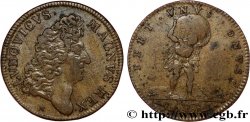
 Details
Details